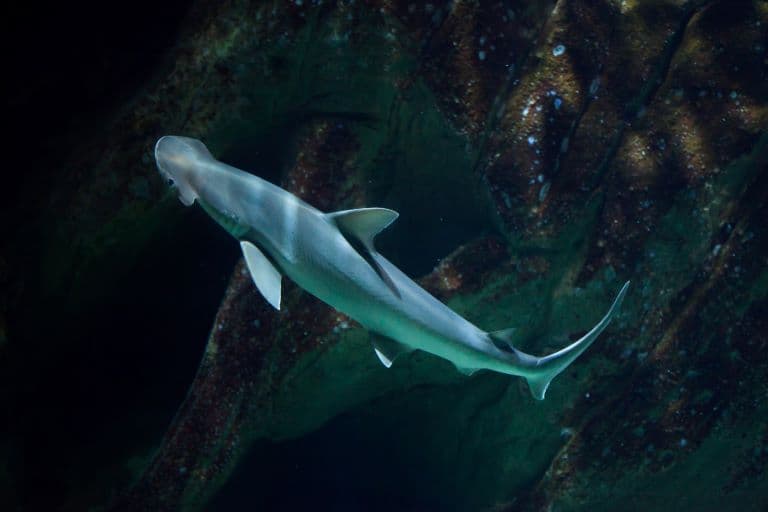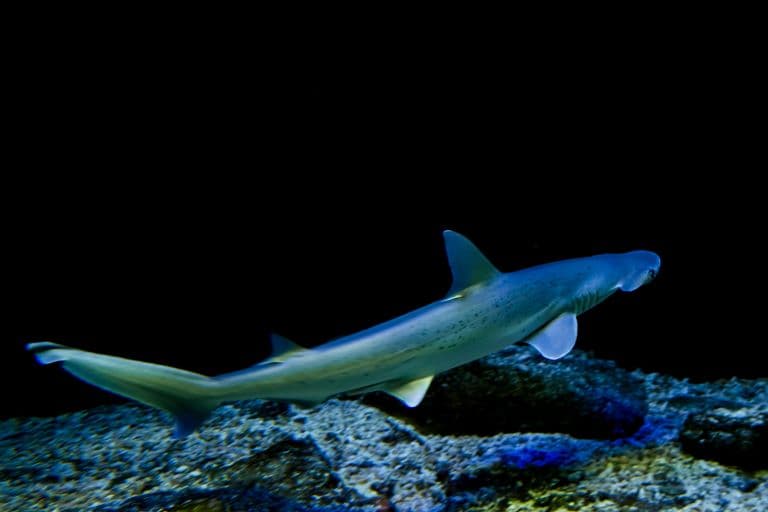Bonnethead Shark Profile
When it comes to sand-scanning, and electroreceptive predation, nothing beats a good hammerhead. Their greatness is compounded by the impressive sizes – a giant example might be six meters long! But there’s a younger, smaller sibling in this genus that rarely gets as much attention.
While not exactly a hammer, the bonnethead shark still packs a serious weapon, and this little relative of the iconic hammerhead is in desperate need of help.

Bonnethead Shark Facts Overview
| Habitat: | Coastal, inter-tidal zone, estuaries, bays |
| Location: | Warm waters surrounding the Americas |
| Lifespan: | Unknown, more than12 years |
| Size: | Around 1.5m (5ft) long |
| Weight: | 11kg (24lb) |
| Colour: | Grey, dark grey, countershaded |
| Diet: | Crabs, shrimps, bivalves, snails, bony fishes, some seagrass |
| Predators: | Larger sharks, humans |
| Top Speed: | Slow |
| No. of Species: | 1 |
| Conservation Status: | Endangered |
Bonnetheads are petite relative to most in the genus, but they’re no less impressive when it comes to hunting prowess. They’re the only known shark to exhibit their special kind of head morphology, which they use as a scanner, to pick out crustaceans and fish from under the sand.
They’ll even eat grass on occasion! These are small, fast-breeding sharks, but even they are struggling with the overexploitation of our oceans, and need to be quickly protected to allow them to recover.
Fortunately, qualified researchers do a good job of keeping them in captivity, and we are gleaning some important information from them in this setting.
Interesting Bonnethead Shark Facts
1. They’re hammerheads
Bonnethead sharks are the lesser-known members of the hammerhead genus, relegated to relative obscurity by the sheer iconic awkwardness of the hammerhead’s face.
But like their famous relatives, bonnetheads have characteristic facial apparatus, and like the larger hammerheads, they use it as a sand scanner, waving a delicate array of electroreceptors across the sandy sea bed to discover the tasty animals hiding just beneath it.
This species is pretty small and its choice of meal reflects this. While man hammerheads will be looking for flatfish, this one prefers crustaceans and bivalves.

2. They’re sexually dimorphic
Male and female sharks are often different from one another in terms of size, but they’re rarely a different shape. And bonnetheads are the only known species of shark to present with differently shaped heads, depending on the sex of the shark.
Males have a bulge along the back of the head disc, or cephalofoil. This is different from the female’s head, which is broader and rounder, with no bulge.
This may be the most primitive form of sexual dimorphism in vertebrates that exists. 1
3. They like a little grass now and then
Shark digestive systems are specialised for flesh. They have all the tearing and grabbing apparatus up the front for that, too, but this species goes against the grain somewhat and has been witnessed eating seagrass.
And this isn’t just a nibble here and there, like a cat that wants to purge something, it’s a full-blown vegan meal for what is essentially an obligate carnivore.
You’d think this might have some kind of physical, rather than chemical benefit to the fish, but researchers discovered the presence of a cellulose-digesting enzyme in the hind gut and established that the shark was digesting around half of the seagrass they took in.
Here is a shark, eating – and digesting – grass. 2

4. They’re kept in captivity
One way people are so able to study this animal is by keeping it in captivity. Being a small shark, it’s one of the easiest hammerheads to keep, but it still has some pretty finicky requirements.
Their swimming habits don’t make them ideal candidates for the aquarium, so a very large tank is required. They also don’t do well with corners and are known to panic when they find themselves in one.
Since they can’t swim backwards, they just thrash about in a panic, scuffing up their specialised facial organs and potentially becoming very poorly.
So, they’re not ideal for the amateur keeper, but they can be kept and studied by qualified professionals fairly well. 3

5. Nets are wiping them out
And this is very helpful, because, in the wild, they’re struggling.
Like so many shark species, this one is on the way out.
Bonnetheads are targeted directly across their range, and they often get caught up in nets that weren’t specifically meant for them too. This is true for commercial, sport and artisanal fisheries alike. The increase in human population has only ramped up the problem, and bonnetheads are one of thousands of victims of over-exploitation of the ocean.
As the species is now in rapid declines all over, these little hammerheads are now listed as endangered by the IUCN. 4
6. They would make a rapid comeback
But of all species of shark, this one stands one of the best chances at bouncing back. They’re fast breeders, and one of the most productive species, meaning that if they could just be given a break they’d increase in number very rapidly.
Their population growth is said to be around 1.3 per year.
7. They can possibly reproduce without males
Bonnetheads might not even need to mate to achieve this. A Nebraska zoo claims to have had one in captivity that gave birth to young with no male present.
This female had been housed for three years with no access to a male bonnethead shark, before giving birth in what many are calling parthenogenesis, or “virgin birth”.
Unfortunately, the new pup was killed by a stingray shortly after being born, but the event raises plenty of questions.
Tissue analysis showed there was no male DNA in the pup, which more or less concludes that this is possible, but until recently, this was not something that was known to happen in sharks at all. In vertebrates in general it is exceptionally rare, and much more common in invertebrates. 5
Bonnethead Shark Fact-File Summary
Scientific Classification
| Kingdom: | Animalia |
| Phylum: | Chordata |
| Class: | Chondrichthyes |
| Order: | Carcharhiniformes |
| Family: | Sphyrnidae |
| Genus: | Sphyrna |
| Species: | tiburo |
Fact Sources & References
- “SEXUAL DIMORPHISM IN ELASMOBRANCHS”, Florida Atlantic University.
- Samantha C. Leigh (2018), “Seagrass digestion by a notorious ‘carnivore’, The Royal Society.
- Brian M. Scott, “Top of the Food Chain: The Bonnethead Shark Sphyrna tiburo: Is it Suitable for Home Aquariums?”, Tropical Fish Magazine.
- “Bonnethead Shark”, IUCN Red List.
- (2007), “Captive shark had ‘virgin birth”, BBC News.
